I’ve been a bad blog-reader this week, but here are a few links.
American Duchess again with a pair of very interesting stays.
A Fashionable Frolic point toward a new online costume exhibition.
It’s hard to to not point to. This time with some interesting 18th century gowns.
Monday, 31 January 2011
Saturday, 29 January 2011
Building a 1940's wardrobe
I have started a new blog. Being possibly insane I have decided to make myself a 1940's wardrobe, which you can find here:
http://fortieswardrobe.blogspot.com/
In my library I have a Swedish book from 1944 called "Alla kvinnors bok", which translated to English means "Every Woman's Book". It's a rather thick volume that covers a lot of things like proper behaviour, housekeeping, decorating a home, marriage and children. Those subjects are all at the end of the book, the first half covers the most important subjects of all, beauty and clothes. As a time document it is all very interesting, but it is just those first chapters that got me thinking a night when I couldn't sleep and I leafed through the book while drinking tea. The book describes how a woman with the ability to sew can create and vary a good wardrobe, if she plans a little. There is a four-year plan how to achieve that and the idea occurred to me that it would be fun and interesting to try to do just that. I like the fashions of the 1940's. I like to sew.
The idea would be to start now with the autumn/winter wardrobe so I have it when it's time to wear it. Though I have a fair knowledge of the fashion of the time, I'm not an expert, so I expect this to be a learning experience for me. I will also need to adapt the clothes so that they will be wearable for me. I don't think I will wear these clothes every day, but I want them to work for every day. There is also the question of materials. Is it possible to use the same materials? Do I want to use some of them, like real fur? And, of course, I need to make these clothes within my budget.
So why a new blog when I already have Isis' Wardrobe? Well, I feel that this is such a special project, that it needs a space of it's own. A place to collect what I do, resources and hopefully some interesting discussions along the way. To call it Fashionable Forties is perhaps not the most original, but that was what my brain came up with. And being in my forties as well, makes it a bit of a pun. So I hope you will find this venture interesting. And perhaps you would care to join in? I would love to see what others would make out of it.
http://fortieswardrobe.blogspot.com/
In my library I have a Swedish book from 1944 called "Alla kvinnors bok", which translated to English means "Every Woman's Book". It's a rather thick volume that covers a lot of things like proper behaviour, housekeeping, decorating a home, marriage and children. Those subjects are all at the end of the book, the first half covers the most important subjects of all, beauty and clothes. As a time document it is all very interesting, but it is just those first chapters that got me thinking a night when I couldn't sleep and I leafed through the book while drinking tea. The book describes how a woman with the ability to sew can create and vary a good wardrobe, if she plans a little. There is a four-year plan how to achieve that and the idea occurred to me that it would be fun and interesting to try to do just that. I like the fashions of the 1940's. I like to sew.
The idea would be to start now with the autumn/winter wardrobe so I have it when it's time to wear it. Though I have a fair knowledge of the fashion of the time, I'm not an expert, so I expect this to be a learning experience for me. I will also need to adapt the clothes so that they will be wearable for me. I don't think I will wear these clothes every day, but I want them to work for every day. There is also the question of materials. Is it possible to use the same materials? Do I want to use some of them, like real fur? And, of course, I need to make these clothes within my budget.
So why a new blog when I already have Isis' Wardrobe? Well, I feel that this is such a special project, that it needs a space of it's own. A place to collect what I do, resources and hopefully some interesting discussions along the way. To call it Fashionable Forties is perhaps not the most original, but that was what my brain came up with. And being in my forties as well, makes it a bit of a pun. So I hope you will find this venture interesting. And perhaps you would care to join in? I would love to see what others would make out of it.
Monday, 24 January 2011
Monday blogaround
More interesting links.
American Duchess has got one of her designs made up by Garmz. It’s a nice coat and I think Garmz is a neat idea.
Needle N' Thread reviews a book about blackwork. Want that one!
I hope Operafantomet doesn’t mind that I link to two of her posts. First a post on extant clothes in Norway . Check out the 18th century stays with the rather original boning placement.
And second, A post on an extant 16th century gown.
American Duchess has got one of her designs made up by Garmz. It’s a nice coat and I think Garmz is a neat idea.
Needle N' Thread reviews a book about blackwork. Want that one!
I hope Operafantomet doesn’t mind that I link to two of her posts. First a post on extant clothes in Norway . Check out the 18th century stays with the rather original boning placement.
And second, A post on an extant 16th century gown.
Saturday, 22 January 2011
More 1790's stays
The stays are coming along very nicely and I think they will be finished pretty soon.
Most extant stays I have read about are finished pattern piece by pattern piece and then whipstitched together. However, there is an Swedish example in Brita Hammar and Pernilla Rasmussen's Underkläder that have been put togther with the right sides of the pattern pieces put together and then stitched like that. It is noted that these stays probably wasn't made by a staymaker, but as I'm not a staymaker, I don't feel bad that I make them like that. I started with sewing the front and back together, putting the right side of the bottom layer of linen to the right side of the silk (which has been basted together with the second layer of linen previously).

I then pressed the seams, folded so the right sides are, well, right, pressed again and then basted the three layers together.

Then I sew all the pieces togther, pressed the seams and stitched them down. It should be noted though that I have never seen stays being made that way so I don't claim any historical acuracy here, but it works for me.

The boning channels were next. My original plan was to make the stays fully boned, but after looking through Underwear: Fashion in Detail I fell for the green stays on page 122, which has pretty cross-stitched decorations. I'm not copying the boning pattern, or the decorations slavishly, but I'm using that for inspiration. The boning channels are sewn with white linen thread that I inherited from my grandmother- she used it in lace-making. I like it, because the stitches shows up better than with ordinary thread. The boning channels are 1 centimetre wide and the channels for the decorations either 5 or 8 milimetres wide.
The lacing holes are sewn with the same linen thread, vaxed. One of these day I'm going to becoming great at sewing them, but that day isn't here yet...

Another alteration to my original plan was the decision of binding the stays with chamois leather. A little digging brought me a supplier in Sweden and it took me two days to get it. It's very soft and supple and has a pale yellow colour. To rest my hands a little a took a pause in making the lacing holes and cut out strips of the leather and bound the stomacher. I can tell you that with a sturdy needle it was no problem at all to sew on a machine. The leather is quite stretchy and it was very easy to sew the point of the stomacher. I wouldn't sew the binding of a pair of tabbed stays a machine, but I will on this pair.

Folded over and stitched to the backside. The binding is 5 milimetres wide and much more padded than a fabric binding. Not a bad thing when it comes to stays.

My next step will be to cut out the shoulder straps and attach them. Then decorate the stays, my plan is to use white and pale yellow silk for the cross-stitch. Boning, binding and then put in the lining. It's a fun project and I look forward to try them on.
Most extant stays I have read about are finished pattern piece by pattern piece and then whipstitched together. However, there is an Swedish example in Brita Hammar and Pernilla Rasmussen's Underkläder that have been put togther with the right sides of the pattern pieces put together and then stitched like that. It is noted that these stays probably wasn't made by a staymaker, but as I'm not a staymaker, I don't feel bad that I make them like that. I started with sewing the front and back together, putting the right side of the bottom layer of linen to the right side of the silk (which has been basted together with the second layer of linen previously).

I then pressed the seams, folded so the right sides are, well, right, pressed again and then basted the three layers together.

Then I sew all the pieces togther, pressed the seams and stitched them down. It should be noted though that I have never seen stays being made that way so I don't claim any historical acuracy here, but it works for me.

The boning channels were next. My original plan was to make the stays fully boned, but after looking through Underwear: Fashion in Detail I fell for the green stays on page 122, which has pretty cross-stitched decorations. I'm not copying the boning pattern, or the decorations slavishly, but I'm using that for inspiration. The boning channels are sewn with white linen thread that I inherited from my grandmother- she used it in lace-making. I like it, because the stitches shows up better than with ordinary thread. The boning channels are 1 centimetre wide and the channels for the decorations either 5 or 8 milimetres wide.
The lacing holes are sewn with the same linen thread, vaxed. One of these day I'm going to becoming great at sewing them, but that day isn't here yet...

Another alteration to my original plan was the decision of binding the stays with chamois leather. A little digging brought me a supplier in Sweden and it took me two days to get it. It's very soft and supple and has a pale yellow colour. To rest my hands a little a took a pause in making the lacing holes and cut out strips of the leather and bound the stomacher. I can tell you that with a sturdy needle it was no problem at all to sew on a machine. The leather is quite stretchy and it was very easy to sew the point of the stomacher. I wouldn't sew the binding of a pair of tabbed stays a machine, but I will on this pair.

Folded over and stitched to the backside. The binding is 5 milimetres wide and much more padded than a fabric binding. Not a bad thing when it comes to stays.

My next step will be to cut out the shoulder straps and attach them. Then decorate the stays, my plan is to use white and pale yellow silk for the cross-stitch. Boning, binding and then put in the lining. It's a fun project and I look forward to try them on.
Wednesday, 19 January 2011
The elusive velvet
Some things floats around in one’s costume mind, things that you have heard, but that you don’t really know if it’s true or not. One of those things that I have heard several times is that velvet wasn’t used for women’s clothes in the 18th century. How about you? One reason is that there is no evidence for velvet gowns if you read testaments and lists of assets, at least not in Sweden. And the other reason is that there are no extant women’s clothes in velvet from the 18th century. On the other hand there are paintings of gowns that look more like velvet than silk.
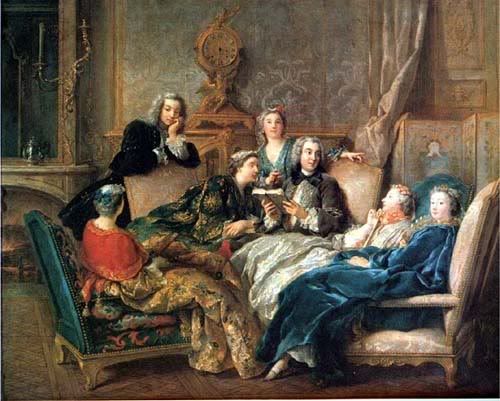
I know, a painting isn’t proof. You can paint in anything in it, but I can’t see why velvet would suddenly be totally absent from female fashions. I can see why it could be less popular, but velvet is nice and cozy and luxurious, so why not have a velvet gown for the cozy winter evenings. This is why I made my wrapping gown in velvet, even if I didn’t have any proof fro velvet gowns.
Well, thank to Pinkdiamond and Corsetrasewing, I now have. A velvet gown , dated to the second half of the 18th century. I wonder why, though- to my eye it looks like the first half.
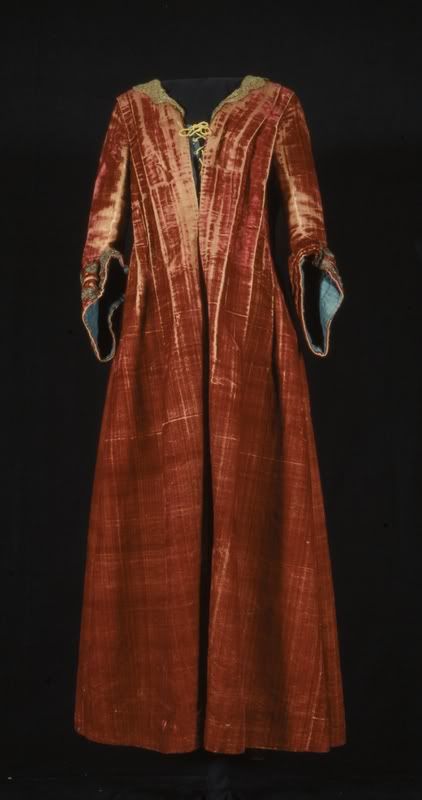
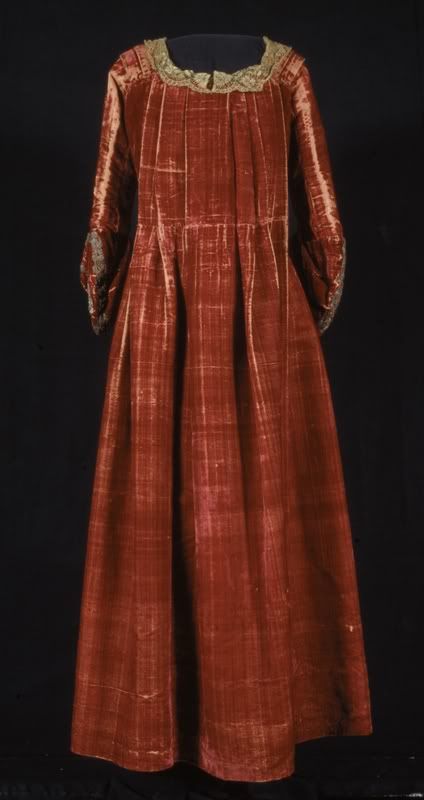
Then there are a number of velvet bodices found here. I don’t speak Spanish, but following Corsetraweing’s advice and searching with the words chronologia, the segle 18, then gipo, then vellut, they can be found. Just bodices, but I don’t think that’s so odd, given how much fabric an 18th century petticoat was made of.
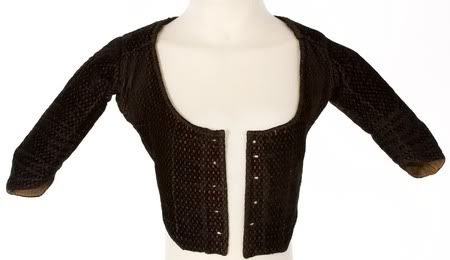
Can’t have been used for anything else than nursing, but I wonder if it was really made like that originally or if it was changed into it after it becomes unfashionable.
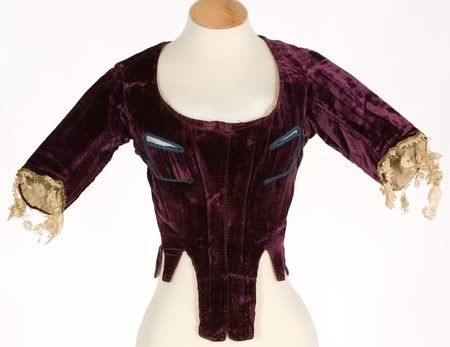
This one looks very Spanish to me.
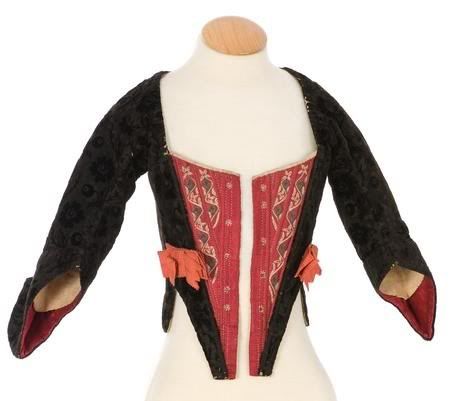
And this one is evidently of the very late 18th century.
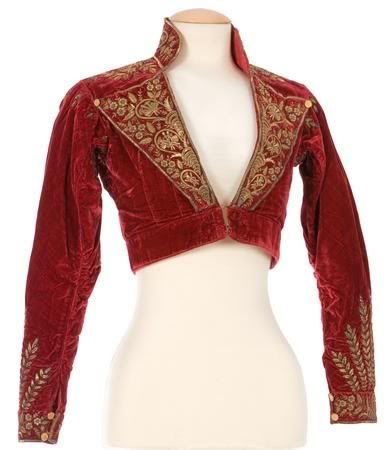
Of course, this is not proof that velvet was used everywhere in Europe. The bodices are Spanish and the gown French or Italian. The painting I have seen which looks like velvet have been German, French and English, so I think it’s likely that it was used, albeit not a lot. I’d love to find out more, though.

I know, a painting isn’t proof. You can paint in anything in it, but I can’t see why velvet would suddenly be totally absent from female fashions. I can see why it could be less popular, but velvet is nice and cozy and luxurious, so why not have a velvet gown for the cozy winter evenings. This is why I made my wrapping gown in velvet, even if I didn’t have any proof fro velvet gowns.
Well, thank to Pinkdiamond and Corsetrasewing, I now have. A velvet gown , dated to the second half of the 18th century. I wonder why, though- to my eye it looks like the first half.


Then there are a number of velvet bodices found here. I don’t speak Spanish, but following Corsetraweing’s advice and searching with the words chronologia, the segle 18, then gipo, then vellut, they can be found. Just bodices, but I don’t think that’s so odd, given how much fabric an 18th century petticoat was made of.

Can’t have been used for anything else than nursing, but I wonder if it was really made like that originally or if it was changed into it after it becomes unfashionable.

This one looks very Spanish to me.

And this one is evidently of the very late 18th century.

Of course, this is not proof that velvet was used everywhere in Europe. The bodices are Spanish and the gown French or Italian. The painting I have seen which looks like velvet have been German, French and English, so I think it’s likely that it was used, albeit not a lot. I’d love to find out more, though.
Tuesday, 18 January 2011
One day late, Monday blogaround
The Lingerie Addict writes about the lack of real women in lingerie advertisement.
La Mode Illustree again, this time with pictures of extant costumes. The first an 18th century robe de cour. I’m not sure if it’s the dummys faukt or iif it has been changed, as the silhouette looks more 1850’s, but it’s still interesting.
Pauline's Pirates & Privateers writes about the real world of piracy, this time on Teach and the “reality” of“Pirates of the Caribeean.
La Mode Illustree again, this time with pictures of extant costumes. The first an 18th century robe de cour. I’m not sure if it’s the dummys faukt or iif it has been changed, as the silhouette looks more 1850’s, but it’s still interesting.
Pauline's Pirates & Privateers writes about the real world of piracy, this time on Teach and the “reality” of“Pirates of the Caribeean.
Sunday, 16 January 2011
More goodies from Nordiska
Not stays, but really nice clothes from the 17th and 18th century. And unusual- what do you think of the patchwork jacket? And I love the ladies shoes from 1653.
Banyan, dated to 1770-1790, in printed cotton dated to 1750
http://www.digitaltmuseum.se/things/morgonrock/S-NM/NM.0186307?pos=12
Banyan, double-breasted in cotton, 1720-1775.
http://www.digitaltmuseum.se/things/rokrock/S-NM/NM.0263181?pos=192
Banyan in red silk, 1740-1770.
http://www.digitaltmuseum.se/things/nattrock/S-NM/NM.0192128?pos=280
Man’s red wedding suit, with embroideries, 1764.
http://www.digitaltmuseum.se/things/brudgumsdrakt/S-NM/NM.0238756A-C?pos=427
Man’s cravat in very fine cotton, with white embroidery
http://www.digitaltmuseum.se/things/halsduk/S-NM/NM.0138957?pos=146
Man’s cuffs with white lace, 1750-1799.
http://www.digitaltmuseum.se/things/armkras/S-NM/NM.0138956A-B?pos=120
Gown 1780-1790 in striped cotton/silk.
http://www.digitaltmuseum.se/things/klanning/S-NM/NM.0022937A-C?pos=475
Woman’s jacket in fine pink wool, 1775-1790, the sleeves cut together with the bodice.
http://www.digitaltmuseum.se/things/troja/S-NM/NM.0025203?pos=69
Woman’s jacket in many-coloured patchwork, 1770-1790. I have never seen anything like that before!
http://www.digitaltmuseum.se/things/kofta/S-NM/NM.0085949?pos=98
Woman’s jacket in black, “shiny” wool, 1770-1799.
http://www.digitaltmuseum.se/things/troja/S-NM/NM.0158626?pos=127
Ripped apart bodice, but the fabric! Oh, the fabric is pink, flowered goodness. I want! 1760-1770.
http://www.digitaltmuseum.se/things/tygprov/S-NM/NM.0178586A-I?pos=422
Stomacher, 1740-1760 in white, quilted cotton, embroidered in white.
http://www.digitaltmuseum.se/things/brostlapp/S-NM/NM.0273749?pos=149
Stomacher, 1770-1779. White linen decorated with striped silk ribbons. Very cute.
http://www.digitaltmuseum.se/things/brostlapp/S-NM/NM.0186310A-C?pos=264
Engageants in white work, cotton, 1750-1779.
http://www.digitaltmuseum.se/things/engageant/S-NM/NM.0081408A-B?pos=95
Woman’s hat in green, 18th century.
http://www.digitaltmuseum.se/things/hatt/S-NM/NM.0214269?pos=283
Pink embroidered shoes in silk, 18th century.
http://www.digitaltmuseum.se/things/skor/S-NM/NM.0087047?pos=100
Blue shoes with white heels, 18th century
http://www.digitaltmuseum.se/things/balskor/S-NM/NM.0003915?pos=298
Mules, 17th century.
http://www.digitaltmuseum.se/things/sko/S-NM/NM.0000649?pos=291
Ladies shoes, 1653.
http://www.digitaltmuseum.se/things/fruntimmerskor/S-NM/NM.0081332?pos=94
Brown embellished gloves, 17th century.
http://www.digitaltmuseum.se/things/handske/S-NM/NM.0114893?pos=113
http://www.digitaltmuseum.se/things/morgonrock/S-NM/NM.0186307?pos=12
Banyan, double-breasted in cotton, 1720-1775.
http://www.digitaltmuseum.se/things/rokrock/S-NM/NM.0263181?pos=192
Banyan in red silk, 1740-1770.
http://www.digitaltmuseum.se/things/nattrock/S-NM/NM.0192128?pos=280
Man’s red wedding suit, with embroideries, 1764.
http://www.digitaltmuseum.se/things/brudgumsdrakt/S-NM/NM.0238756A-C?pos=427
Man’s cravat in very fine cotton, with white embroidery
http://www.digitaltmuseum.se/things/halsduk/S-NM/NM.0138957?pos=146
Man’s cuffs with white lace, 1750-1799.
http://www.digitaltmuseum.se/things/armkras/S-NM/NM.0138956A-B?pos=120
Gown 1780-1790 in striped cotton/silk.
http://www.digitaltmuseum.se/things/klanning/S-NM/NM.0022937A-C?pos=475
Woman’s jacket in fine pink wool, 1775-1790, the sleeves cut together with the bodice.
http://www.digitaltmuseum.se/things/troja/S-NM/NM.0025203?pos=69
Woman’s jacket in many-coloured patchwork, 1770-1790. I have never seen anything like that before!
http://www.digitaltmuseum.se/things/kofta/S-NM/NM.0085949?pos=98
Woman’s jacket in black, “shiny” wool, 1770-1799.
http://www.digitaltmuseum.se/things/troja/S-NM/NM.0158626?pos=127
Ripped apart bodice, but the fabric! Oh, the fabric is pink, flowered goodness. I want! 1760-1770.
http://www.digitaltmuseum.se/things/tygprov/S-NM/NM.0178586A-I?pos=422
Stomacher, 1740-1760 in white, quilted cotton, embroidered in white.
http://www.digitaltmuseum.se/things/brostlapp/S-NM/NM.0273749?pos=149
Stomacher, 1770-1779. White linen decorated with striped silk ribbons. Very cute.
http://www.digitaltmuseum.se/things/brostlapp/S-NM/NM.0186310A-C?pos=264
Engageants in white work, cotton, 1750-1779.
http://www.digitaltmuseum.se/things/engageant/S-NM/NM.0081408A-B?pos=95
Woman’s hat in green, 18th century.
http://www.digitaltmuseum.se/things/hatt/S-NM/NM.0214269?pos=283
Pink embroidered shoes in silk, 18th century.
http://www.digitaltmuseum.se/things/skor/S-NM/NM.0087047?pos=100
Blue shoes with white heels, 18th century
http://www.digitaltmuseum.se/things/balskor/S-NM/NM.0003915?pos=298
Mules, 17th century.
http://www.digitaltmuseum.se/things/sko/S-NM/NM.0000649?pos=291
Ladies shoes, 1653.
http://www.digitaltmuseum.se/things/fruntimmerskor/S-NM/NM.0081332?pos=94
Brown embellished gloves, 17th century.
http://www.digitaltmuseum.se/things/handske/S-NM/NM.0114893?pos=113
Saturday, 15 January 2011
Extant 18th century stays in Sweden
While searching for inspiration for my 1790’s stays I looked through the online collection of stays and bodices belonging to Nordiska museet in Stockholm. And though the text is in Swedish, I thought it could be interesting anyway. The photos are, I’m sad to say, not very large. I have added a short description with every link.
An absolutely gorgeous pair of white brocade stays, 1730-1770. Fully boned, back laced, lined with linen and bound with white leather.
http://www.digitaltmuseum.se/things/snorliv/S-NM/NM.0022164?pos=1
Front laced stays in “sämskinn”, (the only translation I can find are deerskin, which doesn’t seem quite right. It’s pliable and rather thin leather anyway.) 1750-1760. Said to have belonged to a priest’s wife in the provinces. And unusual shape, I think, not as low-cut as stays usually seem to be. Ten fabric pieces and 20 boning channels. Boned with whale bones, and, probably, steel outside the lacing holes.
http://www.digitaltmuseum.se/things/snorliv/S-NM/NM.0004796?pos=2
Fully boned stays in ”sämskinn”, 1750-1770. Back-laced and lined with sturdy linen. More robust whalebone horizontally at the top front and along the waist. Possibly originally a bodice in silk that has been altered into stays.
http://www.digitaltmuseum.se/things/snorliv/S-NM/NM.0001007?pos=1
The museum also has stays that doesn’t have photos (grumble grumble) but descriptions that really wets my appetite.
A bodice to a robe de cour in white silk, 1770-1779. The shape similar to other robe de cour bodices, but the inner layer has probably had stiff paper glued to it before the outer silk layer was attached, which I find interesting.
Stays with a stomacher, 1770-1779 in tan silk.
Stays in unbleached linen, 1740-1760. Back laced, made out of 12 pattern pieces. Bound in “sämskinn”, at the lacing holes pink in colour. Boned with whale bone with a sturdy steel boning set horizontally at the top front. The lining attached after the boning channels were sewn.
Stays in dark brown leather. The museum dates it to 1720-1729, but the stays are dated on the inside with “Anno 1687”. Wouldn’t it be interesting to see them? I wonder if they may be 17th century stays after all. Only four pattern pieces, the side seams well into the back, 12 tabs. The description is a bit fussy, but probably back laced. Bound with “sämskinn”. No mention of boning, but I’m not sure if it’s because the stays suffer from still have a text written when it was acquired (1907) or if it hasn’t any.
These below are not labeled stays (”snörliv”) but bodices (”livstycken”) and have been worn in rural areas in Sweden. Their shape are very close to modern folk costumes in Sweden, though today they are rarely boned and there are indeed unboned bodices from the 18th century too. Anyway, I find these interesting because I have often come across the notion that working women didn’t wear stays. But I find some of these bodices more akin to half boned stays than a bodice. They do seem, however, to have been worn visible, more than as an under garment. Also boned with reed instead of whale bone. Horror upon horror- the wench costume may not have been so historically inaccurate anyway. At least not if you are a Swedish peasant woman.
Bodice in brown sturdy calf skin. Front laced and lined with sturdy linen. Boned with 18 bones, probably reed, except at the lacing holes were it is steel. Overlapping tabs, like scales and a rather pretty inside with patches of leather to enforce the ending of the boning channels.
http://www.digitaltmuseum.se/things/livstycke/S-NM/NM.0001252?pos=145
Bodice in fine blue linen, 1790-1820. Front laced and tab-less, half boned with reed. Very decorative boning channels sewn in white linen thread.
http://www.digitaltmuseum.se/things/livstycke/S-NM/NM.0011974?pos=39
Similar bodice in red wool, 1780-1820.
http://www.digitaltmuseum.se/things/livstycke/S-NM/NM.0031360?pos=44
Bodice in cream-coloured ”sämskinn”, 1750-1799. Front laced with overlapping tabs and sparely boned with reed, steel at the lacing holes. Bound in white leather and have a pretty decoration in pinked white leather. Lined with linen. Supposedly made as an engagement gift.
http://www.digitaltmuseum.se/things/livstycke/S-NM/NM.0194150?pos=31
Bodice in green wool, 1780-1820. Boned with reed at the lacing holes and the seams, boning channels sewn in white linen thread. Lined with linen. http://www.digitaltmuseum.se/things/livstycke/S-NM/NM.0009162?pos=179
An absolutely gorgeous pair of white brocade stays, 1730-1770. Fully boned, back laced, lined with linen and bound with white leather.
http://www.digitaltmuseum.se/things/snorliv/S-NM/NM.0022164?pos=1
Front laced stays in “sämskinn”, (the only translation I can find are deerskin, which doesn’t seem quite right. It’s pliable and rather thin leather anyway.) 1750-1760. Said to have belonged to a priest’s wife in the provinces. And unusual shape, I think, not as low-cut as stays usually seem to be. Ten fabric pieces and 20 boning channels. Boned with whale bones, and, probably, steel outside the lacing holes.
http://www.digitaltmuseum.se/things/snorliv/S-NM/NM.0004796?pos=2
Fully boned stays in ”sämskinn”, 1750-1770. Back-laced and lined with sturdy linen. More robust whalebone horizontally at the top front and along the waist. Possibly originally a bodice in silk that has been altered into stays.
http://www.digitaltmuseum.se/things/snorliv/S-NM/NM.0001007?pos=1
The museum also has stays that doesn’t have photos (grumble grumble) but descriptions that really wets my appetite.
A bodice to a robe de cour in white silk, 1770-1779. The shape similar to other robe de cour bodices, but the inner layer has probably had stiff paper glued to it before the outer silk layer was attached, which I find interesting.
Stays with a stomacher, 1770-1779 in tan silk.
Stays in unbleached linen, 1740-1760. Back laced, made out of 12 pattern pieces. Bound in “sämskinn”, at the lacing holes pink in colour. Boned with whale bone with a sturdy steel boning set horizontally at the top front. The lining attached after the boning channels were sewn.
Stays in dark brown leather. The museum dates it to 1720-1729, but the stays are dated on the inside with “Anno 1687”. Wouldn’t it be interesting to see them? I wonder if they may be 17th century stays after all. Only four pattern pieces, the side seams well into the back, 12 tabs. The description is a bit fussy, but probably back laced. Bound with “sämskinn”. No mention of boning, but I’m not sure if it’s because the stays suffer from still have a text written when it was acquired (1907) or if it hasn’t any.
These below are not labeled stays (”snörliv”) but bodices (”livstycken”) and have been worn in rural areas in Sweden. Their shape are very close to modern folk costumes in Sweden, though today they are rarely boned and there are indeed unboned bodices from the 18th century too. Anyway, I find these interesting because I have often come across the notion that working women didn’t wear stays. But I find some of these bodices more akin to half boned stays than a bodice. They do seem, however, to have been worn visible, more than as an under garment. Also boned with reed instead of whale bone. Horror upon horror- the wench costume may not have been so historically inaccurate anyway. At least not if you are a Swedish peasant woman.
Bodice in brown sturdy calf skin. Front laced and lined with sturdy linen. Boned with 18 bones, probably reed, except at the lacing holes were it is steel. Overlapping tabs, like scales and a rather pretty inside with patches of leather to enforce the ending of the boning channels.
http://www.digitaltmuseum.se/things/livstycke/S-NM/NM.0001252?pos=145
Bodice in fine blue linen, 1790-1820. Front laced and tab-less, half boned with reed. Very decorative boning channels sewn in white linen thread.
http://www.digitaltmuseum.se/things/livstycke/S-NM/NM.0011974?pos=39
Similar bodice in red wool, 1780-1820.
http://www.digitaltmuseum.se/things/livstycke/S-NM/NM.0031360?pos=44
Bodice in cream-coloured ”sämskinn”, 1750-1799. Front laced with overlapping tabs and sparely boned with reed, steel at the lacing holes. Bound in white leather and have a pretty decoration in pinked white leather. Lined with linen. Supposedly made as an engagement gift.
http://www.digitaltmuseum.se/things/livstycke/S-NM/NM.0194150?pos=31
Bodice in green wool, 1780-1820. Boned with reed at the lacing holes and the seams, boning channels sewn in white linen thread. Lined with linen. http://www.digitaltmuseum.se/things/livstycke/S-NM/NM.0009162?pos=179
Friday, 14 January 2011
1790's stays in progress
The fashion of the 1790’s is reeling between the earlier 18th century and the upcoming Regency fashion, and stays seem to reel too. My love for the 1790’s is quite new, but in the last year I have made three gowns from that period, so I felt that it was about time to make a pair of stays that were more correct for the period. Then I got really inspired when Katherine Hay posted about an extant pair in Corsetmakers in December. I want stays like that, the kind that are more like earlier 18th century stays in shape, but shorter and tables. For a pattern I once again turned to Norah Waugh and based my pattern on the front and back-laced pair that have the four stuffed balls attached to the back. I used the pattern I drafted for my un-finished stays as a template and came up with this. Picture of those can be found this old post on my stay-making history.

Mats made sure I did it correctly.

I’m making it out of two layers of white linen and one of light blue silk taffeta. I also added a small stomacher. I have never seen that on stays from that period, but my weight fluctuate a bit and I want stays that I can use even if my weight differs. There will be shoulder straps too, but they aren’t cut yet. Here they are with the silk basted to the linen.

You may wonder why the silk doesn’t completely cover the linen. Well, that has to do with the fabric. Last summer I planned to make a striped robe battante. I wanted it in light blue and white and found the perfect fabric. I ordered and the colours were exactly what I wanted! However, the stripes were not 8 centimeters wide as I thought, but 8 inches… Totally my own fault as the website clearly states the width. So, no robe battante. I do have some plans for the fabric, but there’s a lot of it and I liked the idea of pale blue stays. However, 8 inches are wide, but not as wide as my pattern pieces, so some piercing was necessary.

I know that it would have been easier to choose another fabric, but I got set on having them in this colour, so piercing it is.
I am now in the process of assembling the stays and I hope to show more of them next week. Though I’m full of admiration for those who hand sew their stays completely, my hands can’t handle sewing through all those layers. So I use my machine for assembling and boning channels and then hand stitch the lacing holes and the binding. My plan is to make them fully boned with stitching and other details in white.

Mats made sure I did it correctly.

I’m making it out of two layers of white linen and one of light blue silk taffeta. I also added a small stomacher. I have never seen that on stays from that period, but my weight fluctuate a bit and I want stays that I can use even if my weight differs. There will be shoulder straps too, but they aren’t cut yet. Here they are with the silk basted to the linen.

You may wonder why the silk doesn’t completely cover the linen. Well, that has to do with the fabric. Last summer I planned to make a striped robe battante. I wanted it in light blue and white and found the perfect fabric. I ordered and the colours were exactly what I wanted! However, the stripes were not 8 centimeters wide as I thought, but 8 inches… Totally my own fault as the website clearly states the width. So, no robe battante. I do have some plans for the fabric, but there’s a lot of it and I liked the idea of pale blue stays. However, 8 inches are wide, but not as wide as my pattern pieces, so some piercing was necessary.

I know that it would have been easier to choose another fabric, but I got set on having them in this colour, so piercing it is.
I am now in the process of assembling the stays and I hope to show more of them next week. Though I’m full of admiration for those who hand sew their stays completely, my hands can’t handle sewing through all those layers. So I use my machine for assembling and boning channels and then hand stitch the lacing holes and the binding. My plan is to make them fully boned with stitching and other details in white.
Tuesday, 11 January 2011
Swingdress sew-along
Casey of Elegant Musings have a sew-along on a swingdress, starting today. I’m going to join in. I like the dress, it can be purchased as an e-pattern and I’m pretty sure I can find fabric for it in my stash. Anyone else up for it?
Monday, 10 January 2011
Monday blogaround
Some of the blogs I follow have blogarounds once a week, which I think is a neat idea. I don’t actively seek out new blogs- too time-consuming, and I’m sure one misses some great things and I haven’t seen it much when it comes to costumes. So I will give it a go and hopefully give you four of five links to interesting posts every Monday. Only this time it is three. ..
Diary of A Mantuamaker writes about her Brunswisk jacket, with some informative photos.
La Mode Illustree have posted a series of late 18th century fashion plates. This is a link to the last of four.
Fru Aleydis”> have a wonderfully inspirational cavalcade of last year’s sewing projects.
Diary of A Mantuamaker writes about her Brunswisk jacket, with some informative photos.
La Mode Illustree have posted a series of late 18th century fashion plates. This is a link to the last of four.
Fru Aleydis”> have a wonderfully inspirational cavalcade of last year’s sewing projects.
Thursday, 6 January 2011
12th Night costume
Yesterday Gustafs Skål held their 12th Night Masked ball. Thank you all for all the advice and suggestions regarding my costume! I went as a deer, well, perhaps doe and I was really pleased with my costume and got a lot of compliments.


As you can see I wore my green gown. I have gained weight, so I dug up my old stays from Laila Duran, which also solved the stomacher problem. Gorgeous fabric, isn't it? They proved to be a bit big, though, so they chafed a little.

The antler hat started off as a round metal structure with the antlers integrated. Then I covered the antlers with paper clay that I painted gold and the base was covered with the same fur as the gown. I tied it at the back of my neck, and then pinned on the organza veil. I was a bit worried that it would fall off, but it stay put all evening. I did powder my hair, though you can't see much of it.

Unfortunately my camera misbehaved, so after MetalMarianne kindly took these photos, I couldn't use it anymore. Which is a pity, because there was a lot of lovely costumes around!

Sometimes I resemble an ice-cream cone...



As you can see I wore my green gown. I have gained weight, so I dug up my old stays from Laila Duran, which also solved the stomacher problem. Gorgeous fabric, isn't it? They proved to be a bit big, though, so they chafed a little.

The antler hat started off as a round metal structure with the antlers integrated. Then I covered the antlers with paper clay that I painted gold and the base was covered with the same fur as the gown. I tied it at the back of my neck, and then pinned on the organza veil. I was a bit worried that it would fall off, but it stay put all evening. I did powder my hair, though you can't see much of it.

Unfortunately my camera misbehaved, so after MetalMarianne kindly took these photos, I couldn't use it anymore. Which is a pity, because there was a lot of lovely costumes around!

Sometimes I resemble an ice-cream cone...

Tuesday, 4 January 2011
To powder my hair or not?
Tomorrow I’m going to attend an 18th century masked ball. My costume has a rather woody theme and my modern me thinks that I ought to look natural. But would an 18th century lady really think like that? Especially since my costume is early 18th century. I don’t think looking natural really had any importance. And I really like the effect of powdered hair- it’s really not used much in my society. Probably because it is a bit of a fuzz to fix. So I’m thinking to and fro and can’t decide.
Monday, 3 January 2011
Deridolls
During the year I feel in love with the very cute dolls from Deridolls. Deviantart gallery here. They are inspired by paintings, characters from movies or books, or whatever. So I decided to give away some for Christmas.
My sister got the character Eponine from the musical Les Miserables. It’s a character who means a lot for my sister, so I hoped she would like the doll. And I think she did!

I also ordered, to give to Janne, a mini-me based on this outfit.

Here I am!
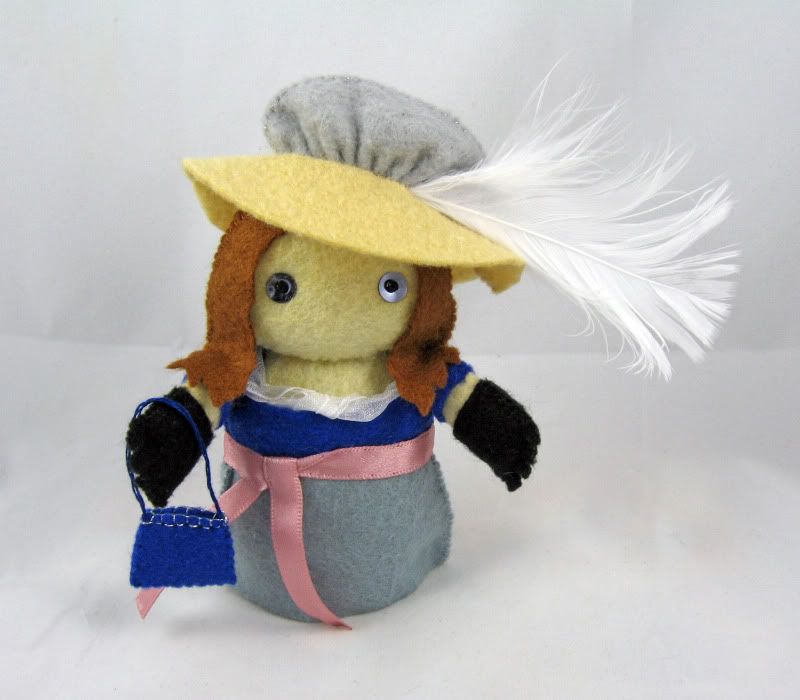
The bag has been changed in shape to look more like my own bag, otherwise this is it. I’m especially pleased with the hat!
My sister got the character Eponine from the musical Les Miserables. It’s a character who means a lot for my sister, so I hoped she would like the doll. And I think she did!

I also ordered, to give to Janne, a mini-me based on this outfit.

Here I am!

The bag has been changed in shape to look more like my own bag, otherwise this is it. I’m especially pleased with the hat!
Subscribe to:
Posts (Atom)